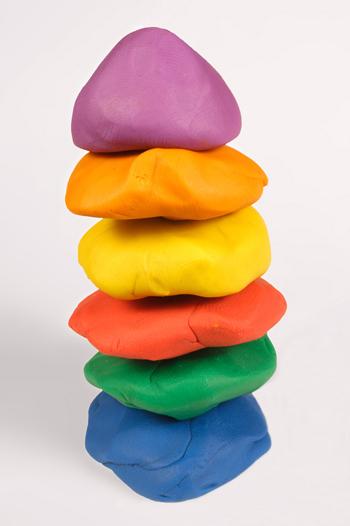Make your own playdough
Duration/age

Making your own playdough is easy and your child will be learning as they go. Ask your child to help you find the ingredients in the cupboard. They can measure them out ready to mix.
Fill the measuring cup right to the top. That makes one cup. Now we need another cup of flour. That makes two cups of flour.
Mix all the dry ingredients together in a bowl. Add the oil and food colouring. Pour the boiling water into the bowl, making sure your child stands back to avoid splashing. Now you can take turns to mix the dough with a wooden spoon. When the dough has come together in a lump turn it out of the bowl and knead it. Kneading means folding and pushing the dough together until it is smooth.
Recipe for playdough:
- 2 cups of plain flour
- 4 tablespoons of cream of tartar
- 2 tablespoons of vegetable oil
- 1 cup salt
- a few drops of food colouring
- 2 cups of boiling water.
Now you can play!
Materials you will need
- Spoon
- Bowls
- Playdough recipe
- Measuring cups
- Wooden spoon
- Kettle
Skills this activity improves
Why does this matter?
While your children are making the dough they will be learning about measurement, size, the sequence of the recipe, and the way ingredients change as we mix them together. They will be learning and using new words like tablespoon, stir and knead. They will be using their senses as the dough is mixed.
What does this lead to?
Children will be developing an understanding about relative sizes like a teaspoon is smaller than a tablespoon. They will be developing an understanding about quantity like two is more than one. They will also be experiencing textures like dry and smooth.
Language to use
- Flour, salt, oil, cream of tartar, food colour, water
- Cup, tablespoon, measure
- Stir, mix, knead
- Hot, boiling, cool, cold
Questions to use
- Can you fill the cup all the way to the top with flour?
- What colour shall we make the dough?
- What do you think will happen when we pour the water in?
- How does the dough feel?
Useful tips
- Playdough keeps really well in an airtight container or in a plastic bag.
- If the dough gets sticky try adding a little more oil and kneading it in.
- Remind your child that playdough is not for eating. Too much salt can make babies sick.
- You might also want to look at the Playing with playdough activity.
- Remember to talk to your child in your home language.
More ideas
- You can add different textures to the playdough. Try adding rice, sand or glitter.
- Add some different scents to the playdough. Try making some peppermint or lemon scented dough. Spicy dough is good for making pretend buns with.
- Once you can cook playdough you can cook food as well. Try scones as they are a lot like dough.
Variation by age
Birth to two year olds
- Younger children enjoy kneading the dough. You can roll out the dough and they can cut it or use biscuit cutters. Pressing shapes or making patterns in the dough is also fun. You could use items like shells, a fork or a toy car.
- Make some patterns with the shapes.
Three to five year olds
- Make a pretend cooking activity by adding patty pans, pop-sticks, a rolling pin, and a baking tray. You could use a cardboard box as the oven.
- To change what your child will do with the playdough, try adding little plastic animals. You could make a jungle and add some bits of bushes for trees. Maybe you could bury the animals in the dough and search for them like a palaeontologist.
- Show your child how to roll the dough into long ‘snakes’. See if they can make the letters of their name with the snakes.
Questions to use
- How does the dough feel?
- Can you make some patterns?
- What happens when you roll the car on the playdough?
Questions to use
- What shall we make with the playdough today?
- Can you make a C or an M?


